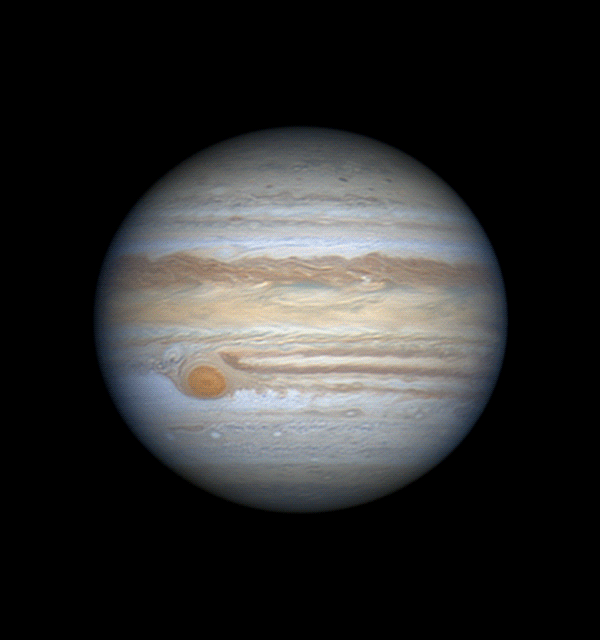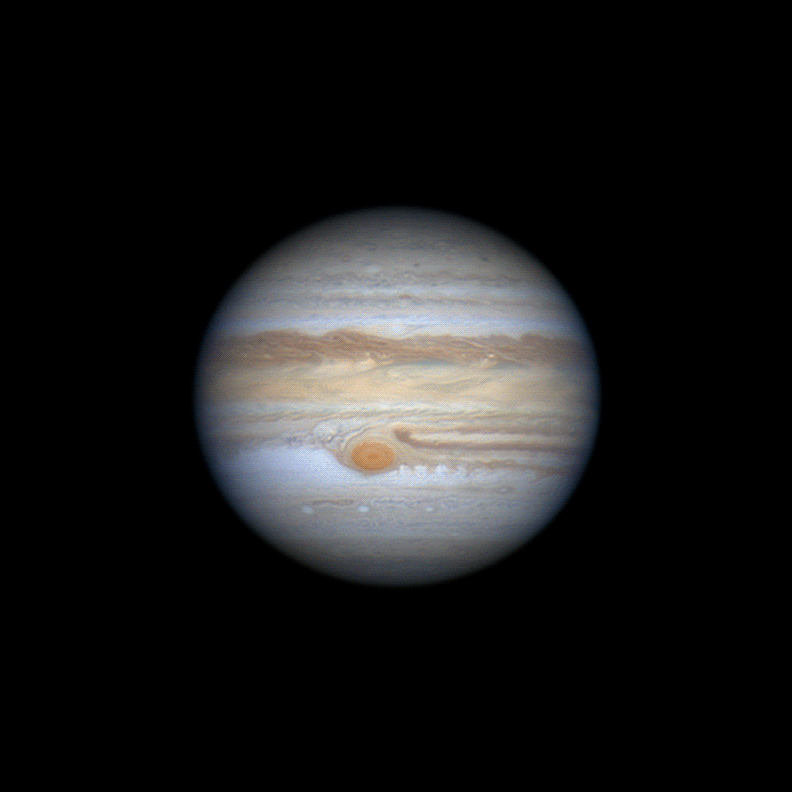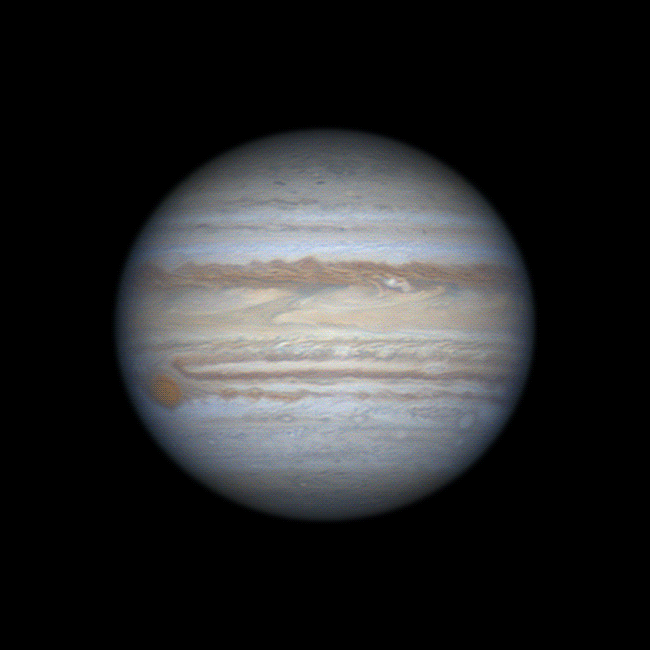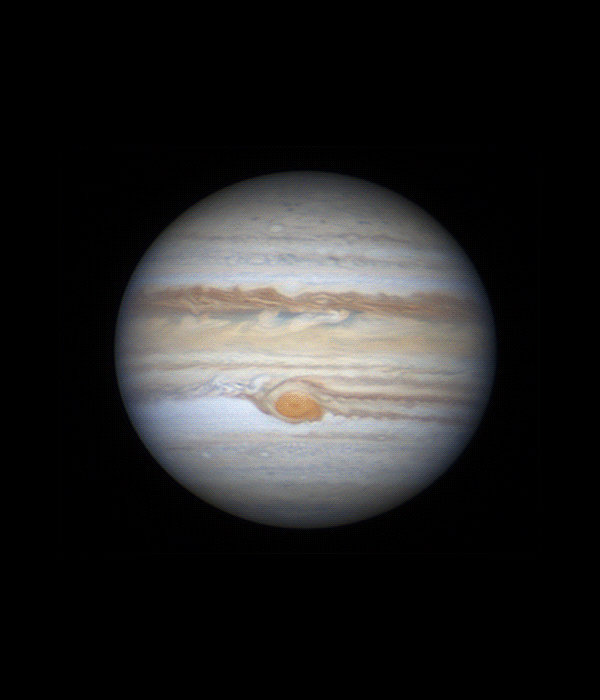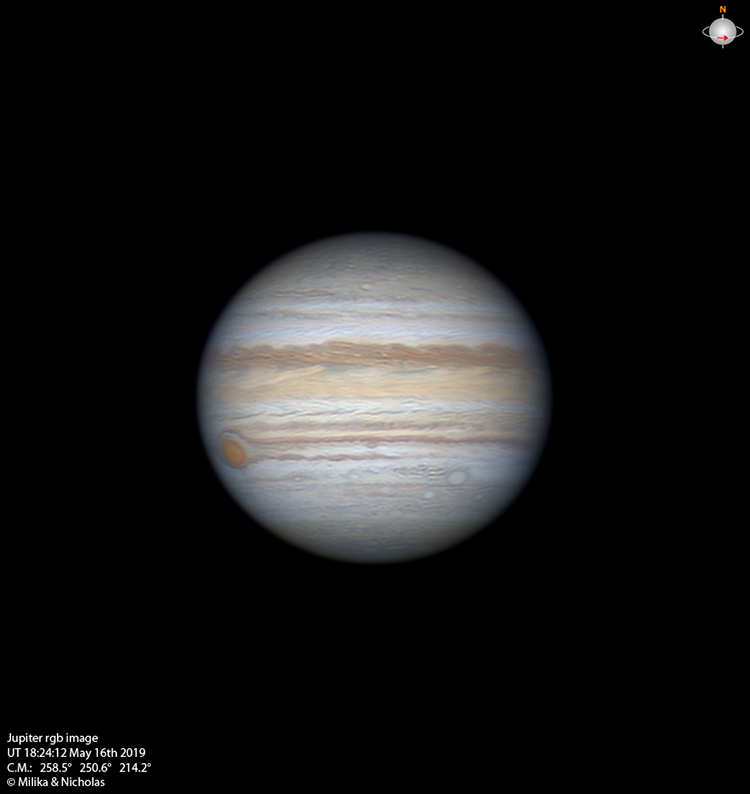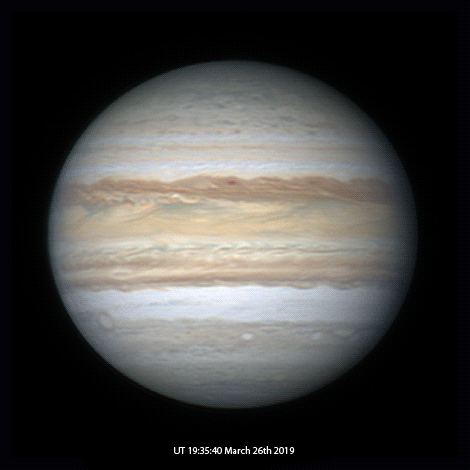|
ART ASTRONOMY Uranus
2023 on Sun, Moon, Venus & Miscellaneous PROCESSING
TUTES |
JUPITER 2019 |
|
Note: Most of the images on this page are
"clickable" and will open up as "full scale images" in a
new tab. |
|
|
2nd
Oct2019 |
|
|
|
|
|
13th
Sept 2019 |
|
|
|
|
|
|
|
|
The next
set of images immediately below, are a record of the appearance of the
Southern Hemisphere of Jupiter with the GRS activity in particular…displayed
as a portion of a South Polar Projection map of the planet. They are
not a complete polar projections of the South. Hemi. Because each image is
cut off without displaying the South Pole regions specifically…but still give
very good examples of the activity in those regions I wished to highlight. |
|
|
10th
August 2019 |
|
|
The
following 9 images represent the most recent captures we have made of
Jupiter: as mentioned further below activity in the GRS (Great Red Spot) this
year has attracted a lot of attention with people using the terms “blades”or
“flakes” to describe what appeared to be portions of this huge storm “peeling
off” – the latest professional explanations appear to refute this notion
& lean towards the idea that we are actually witnessing material that is
being drawn into the main body of the GRS. (see June 12th comments
re the GRS further down) Although
the GRS has clearly “shrunk” over time none of the images we have captured
this year gave any clear indication that this was accelerating markedly over
the last few months: interested in looking at our own images where we took
numerous hi-definition examples of this phenomenon, I put together a
comparison immediately below. Using 2
images almost 2 months apart & re-scaling the larger image to the same
scale as the smaller one I then made an inset for better comparison…also
including a suitably-scaled inset of the GRS from April 15th as
well. (on June
12th Jupiter was 46.0 arcseconds in apparent diameter, being
nearer to Earth, whilst on August 10th it was further away &
only 41.3 arcseconds – written as 41.3”…on April 15th it was
41.4”) Effectively,
the image details below suggest that over the nearly 4 months from April to
August, very little real differences can be discerned in the overall size of
the GRS…perhaps supporting the latest ideas in that aspect of the current
appraisal of GRS activities. |
|
|
Part of
the above investigations had me going back through all the image captures of
2019 where the GRS was on display - quite a number as it turns out! ;) -
& I have arranged some of these in chronological order from the latest to
the earliest immediately below. I have not
scaled the images relative to each other so you need to ignore the size
differences, as some images were taken from much larger representations of
the planet – to standardise the scale requires a lot more work but it is a
worthwhile enterprise where quite a deal more might be gleaned from them -
& also allow me to make an interesting animated sequence over that 4
month period. |
|
|
The
following 7 images were all taken at Leigh Creek in the north of South
Australia: the winds were very savage & it was difficult to keep Jupiter
on the camera screen…but amazingly the end-results were quite outstanding in
such conditions! We were
able to capture many videos (avi’s) & put together this animation showing
the rotation of Jupiter over a 2 hour period: as usual this is a “reversing
animation” where once the period of rotation captured from left to right is
finished, the animation reverse-plays back to the start! J |
|
|
Here is an
extra-large view of the GRS & surrounding area from that night’s images. |
|
|
|
|
|
A
selection of the rest of the August 10th images of Jupiter. |
|
|
29th
July 2019 |
|
|
15th
July 2019 One of the
rare occassions this year where Jupiter’s GRS was not on display& we
could see the other side of the planet..! :) |
|
|
|
|
|
|
|
|
June 20th 22nd 23rd
& 25th Comparison On 20th June we travelled to
Natimuk in the West Wimmera region of Victoria to escape the constant Cloud
coverage in our home state of South Australia. This provided us with a number of nights
of very good seeing where a great deal of detail in & around the GRS can
be seen: furthering our own personal record of the activity that has been
occurring there. The first image below shows the results
of the 4 nights we imaged Jupiter: the 3rd night (23rd
June) was the poorest but still provided quite a lot of detail. |
|
|
June 20th 22nd
& 25th GRS Comparison The 3 images below concentrate on the GRS
& the activity in & around this Jovian feature in close-up. |
|
|
June 25th 2019 Our last night at Natimuk produced the
images below: the first is an image displayed at 125% greater than capture
scale. Then next as a set of 4 at capture scale
as the RGB (colour) image & the 3 separate channels (red, green &
blue) that make up the colour image. |
|
|
23rd June 2019 With the GRS “setting” (about to
disappear around the right hand limb/edge of the planet’s disk) this image
set from the 23rd was the poorest result from the 4 nights – but
still a very satisfying image to achieve. |
|
|
22nd June 2019 Another good night with an image at 125%
capture scale, then the set of 4 (colour, red, green & blue channels)
& finally an animated sequence showing Jupiter rotating over a set period
of time. The blue channel image in the set of 4
(bottom right) is quite outstanding in its’ clarity & detail: this
indicates how steady the atmosphere was at Natimuk…described as “very good
seeing” by planetary imagers..! J |
|
|
20th June2019 |
|
|
The first night at Natimuk: again we see
an image of Jupiter at 125% of capture scale (ie,
enlarged) with a lot of detail. Then the set of 4 images, & lastly
another animated sequence: this one is made up of many more images (frames)
& over a much greater timespan than the one above, resulting in a longer
rotational movement & smoother appearance. |
|
|
12th June 2019 |
|
|
All of the images below going down to May
16th this year are focused upon the “GRS” or “Great Red Spot” of
Jupiter. This is an enormous anti-cyclonic feature
that has reliably been reported as part of Jupiter’s upper (visible)
atmosphere for over 300 years & perhaps is much older still. (Cassini
first reported this feature in the 1600’s – ie, 17th
Century) Over the last 2 centuries it has become
apparent that this feature is actually shrinking - & since the start of
this current century that shrinking appears to be accelerating more! The GRS is constrained & “spins”
between 2 powerful jetstreams travelling in
opposite directions (one above & one below) & often “feeds” off
smaller storms that enter its influence from the North-West. (upper left in
these images whereby Jupiter actually rotates from left to right) Over the years it has also changed in
hue/colour as well as shrunk: around the GRS also lies a “boundary zone” or
“clearing” known as the “GRS Hollow” but lately (since April/May of this
year, sections (colloquially termed “flakes” or “blades” etc) appear to have
detached themselves from the actual, visual red/orange GRS itself &
streamed off, creating a dark collar & noticeable “streamers” preceding
& proceeding the GRS, replete with storm spots & projecting threads
of darker material such that they virtually ring the planet at those
latitudes. Just exactly what is happening & what
the (possible) end-results of all this activity is has become the subject of
much excited conjecture amongst both professionals & amateurs alike: our
own view is that whatever is occurring may be long-lasting such that major
changes to the GRS & associated regions “might” occur…but alternatively
this current “behaviour” might well be only transient, & regardless of
any alleged shrinkage & colour changes etc, the GRS might well resume
“normal service” - but it is certainly exciting to observe at present as we
“wait & see”..! ;) The images below provide some very good
definition of the features concerned & we hope to be able to gather more
in the coming weeks – if the prevalence of clouds & rain allow us to! |
|
|
This animated
sequence of Jupiter at the scale/size we captured it at displays the GRS
advancing from left to right around Jupiter, rising on the left: the GRS
activity mentioned above can be well-seen here. |
|
|
|
|
|
7th June 2019 |
|
|
6th June 2019 |
|
|
22nd May 2019 |
|
|
|
|
|
|
|
|
The image
below features an inset with the GRS enlarged somewhat to better see this
feature & the activity within/around it. |
|
|
Here we
see the individual colour channels from an image of Jupiter with the GRS
“front & centre.” |
|
|
16th May 2019 |
|
|
In the
image below & the enlarged inset we see the feature called “Oval BA”
which is another large Jovian storm: there are also 2 other smaller storm
spots below & to either side of it. Oval BA
was distinctly red a few years back but has gradually faded in the interim:
this feature “precedes” the GRS (meaning goes before with regard to Jupiter’s
rotation) & if you look at the image directly above you can just see the
GRS coming into view following after Oval BA. |
|
|
22nd April 2019 |
|
|
On this particular night the seeing &
imaging outcomes were not what we might have hoped for but we took the
opportunity to make sure our captures included the major moons of Jupiter:
Io, Europa, Ganymede & Callisto, also known as the Galilean Moons. In the following animations they can be
seen shuttling around Jupiter like a mini Solar System as Jupiter itself
rotates. (only small part of their orbits are shown here & these
animations incorporate a “reversing” aspect to give a smoother animation. The “sulphurous” yellow hue of the
darkened EQ (Equatorial) zone of Jupiter is well seen in the following images
– first noticed during the 2018 pparition. |
|
|
22nd April Jupiter & Moons
Animations - Slow moving animation. |
|
|
Faster moving animation. |
|
|
A “still”
image.to show these moons arrangement about Jupiter at one point in time. |
|
|
|
|
|
15th April 2019 |
|
|
A rather nice image showing quite a bit
of fine detail in the SEB (South Equatorial Belt) around the GRS (Great Red
Spot) as well as the GRS itself. The Galilean Moon Europa can be seen
transiting Jupiter’s disk in this image. |
|
|
|
|
|
Jupiter Rotating Around Red Spot! Most animations of Jupiter display the
planet fixed with the everything rotating as one would expect to view it:
this one takes a somewhat different approach where we fix our point of view
upon the GRS to see a different type of animation! |
|
|
|
|
|
10th April 2019 |
|
|
Here the yellowish “sulphur-like”
colouration of the NEB (North Equatorial Belt) is seen along with the GRS
just in view & to the far right of it & down somewhat the feature
known as the Oval BA – its strong red colour from years before almost now
completely bleached out. The individual filter images are shown here also. |
|
|
6th April 2019 |
|
|
Another image showing the turbulent
clouds surrounding the GRS & an inset of that region at a larger scale to
see this turbulence a bit better. |
|
|
2nd April 2019 |
|
|
|
|
|
26th March 2019 |
|
|
Here the Oval BA is seen on the lower left
of this image of Jupiter: this feature, also known as “Red Spot Junior” was
formerly quite red in colour, but over the past few years has faded very
considerably. |
|
|
Jupiter Animation |
|
|
|
|
|
4 images of Jupiter taken over a period
of just over 1 hour on the same night. |
|
|
6th March 2019 |
|
|
This image shows the Galilean Moon Io
(the closest moon to Jupiter) as it begins to transit (cross) Jupiter’s face
– it’s shadow can be seen preceding it. The shadow always appears to “go
first” in these transits when these images are taken before opposition, the
Sun’s light is coming from the left at these times onto Jupiter & the
moons, hence the shadow of the moon is cast to the right of the moon. At opposition the Sun is shining directly
on Jupiter & its moons for all intents & purposes so the shadow
appears directly below the moon & is invisible for a very short time at
opposition. Once this period has passed then the moon will proceed (go first)
& the shadow will follow, the Sun now shining from the right in this
view! |
|
|
|
|
|
23rd February 2019 |
|
|
Another image with the individual
channels displayed below the rgb image. |
|
|
|
|
|
13th February 2019 |
|
|
An iR610nm image taken in poor seeing
conditions early in this apparition: this filter allows for reasonable
outcomes even if the seeing isn’t up to the standard required to deliver good
rgb images. |
|
|
|
|
|
One of the first imaging session outcomes
for 2019 – the previously mentioned (2018) yellowish colouration of the
EZ (Equatorial Zone) is very evident
here. |
|
|
|
|
|
|
























